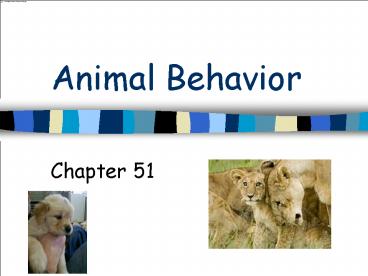Animal Behavior - PowerPoint PPT Presentation
1 / 46
Title:
Animal Behavior
Description:
Cognitive behavior Chimpanzee Nuts Bugs Vervet monkeys and alarm calls Imprinting Cognition Spatial learning ... learning Classical conditioning ... – PowerPoint PPT presentation
Number of Views:275
Avg rating:3.0/5.0
Title: Animal Behavior
1
Animal Behavior
- Chapter 51
2
Behavior
- Animal responds to stimuli
- Food odor
- Singing
3
Ethology
- Study of patterns of animal behaviors in nature
4
Ethology
- Proximate causation
- How the behavior works??
- Ultimate causation
- What is the adaptive value to this behavior??
5
Behavioral ecology
- Study of the ecological evolutionary basis for
animal behavior - Study of how natural selection shapes behavior
6
Innate Behavior
- Developmentally fixed behaviors
- Preset behaviors
- Individuals in a species respond similarly
- Geese retrieving eggs
7
Innate behaviors
- Fixed action pattern
- Sequence of unlearned behavioral acts that are
unchanged - Carried to completion
- Sign stimulus (key stimulus)
- Triggers the behavior
8
Fixed action patternStickleback fish
9
Innate Behavior
- Fixed-Action Pattern
- Begging behavior of new chicks
- Raised heads, open mouths, loud cheeps
- Sign stimulus
- Parent landing at the nest.
10
Behavior
- Taxis
- Movement towards or away from stimuli
- Positive taxis
- Towards a stimulus
- Negative taxis
- Away from a stimulus
- Kineses
- /- nonspecific movement due to stimuli
11
Migratory behavior
- Migration
- Long distant change in location
12
Migratory behavior
- Orientation
- Following a bearing
- Navigation
- Ability to adjust that bearing
13
Communication
- Signal
- Behavior causes a change in another animals
behavior - Communication
- Reception response of a signal
- Auditory, visual, olfactory(chemical), tactile
signal
14
Courtship
- Leads to potential mates
- Species-specific
15
Courtship
16
Bird of paradise
17
Fruit Fly courtship
Orienting
Tapping
Singing
18
Honeybees
- Waggle dance
19
Pheromones
- Chemical signals
- Animal communication
- Mating behaviors.
- Territorial behaviors
20
Pheromones
Minnowsbefore alarm
Minnowsafter alarm
21
Pheromones
22
Learning
- Modification of behavior based on experiences
- Non-associative learning
- Simple
- No association between two stimuli
- Between a stimulus response
23
Habituation
- Loss of responsiveness to irrelevant stimuli.
24
Imprinting
- Sensitive period (critical period)
- Soon after hatching
- Important for normal parent/child behaviors
- Stimulation necessary for normal behavior
- Premies
- Sexual behavior-mating
25
Imprinting (Konrad Lorenz)
26
Spatial learning
- Memory based on environmental clues
- Digger wasps
27
Learning
- Associative learning
- Association between two stimulus
- Stimulus a response
- Behavior is modified (conditioned) through
association
28
Associative learning
29
Associative learning
- Classical conditioning
- Operant conditioning
30
Classical conditioning
- Pairing of two different stimuli
- Ivan Pavlov
- Dogs
- Food, salivate
- Ring bell at same time
- Dog learned to salivate with bell ringing
31
Operant conditioning
- Associate behavioral response with a reward or
punishment - Trial error
- B.F. Skinner
- Skinner box
- Rats would bump lever, food came out
- Learned to hit lever to get food
32
Operant Conditioning
33
Cognitive behavior
- Ability of the animals nervous system to
perceive, store , process - Use information gathered by sensory receptors
34
Cognitive behavior
- Chimpanzee
- Nuts
- Bugs
35
Vervet monkeys and alarm calls
36
Imprinting
Forms oflearning andproblemsolving
Spatial learning
Cognition
Associative learning
Social learning
37
Forging Behavior
- Obtaining food at the least expense
- Energy efficient
- Food vs safety
- Food vs mating
- Food vs protection
38
Territoriality
- Defends an area
- Usually excludes members of own species.
- Exclusive rights
- Food, mating
39
Gannet
40
Cheetah
41
(No Transcript)
42
Reproductive strategies
- Set of behaviors evolved to give maximum
reproduction - Food source
- Nesting sites
- Members of opposite sex
43
Mating relationships
(a) Monogamy
(b) Polygyny
(c) Polyandry
44
Jaw fish
45
Sea elephant
46
Altruism
- Benefits others at the cost of individual































